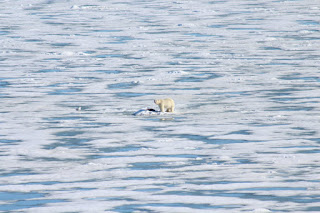The landscape in the far north is less about land, and more
about water in its different forms.
The remarkable thing about being in the frozen North is the
unexpected palette of color found in the ice. Snow and ice and water isn’t all
white or clear - it’s blue... incredible shades of aquamarine and turquoise and
cerulean. The color is dependent on the depth of the water or the consistency
of the ice.
Snow crystals are delicate and airy, and air bubbles are what reflect visual light back out to what we can see. When all colors in the light spectrum are reflected, we see white. Water acts as a filter of lightwaves – under the water, longer wavelengths of light (red-orange-yellow) are absorbed, so things look blue.
GLACIERS
Over a period of thousands of years, snow builds up and packs down, forming huge hunks of ice. When the pressure gets big enough, ice is squeezed through valleys, slowly flowing down in the form of glaciers.
 |
| Clear ice, from the Monacobreen Glacier |
In the case of glacial ice, the pressure of snow accumulation causes the layers below to compress, and eventually all the air bubbles are squeezed out leaving tightly packed H2O molecules. Up close, small pieces of this ice look crystal clear, but en masse, these huge chunks absorb the majority of visible light, only allowing shorter wavelengths to pass through. By the time the light reaches our eyes, only the shortest wavelengths – blue – are present.
The glaciers in the Svalbard are rapidly receding - when we visited the enormous Monacobreen glacier we were in uncharted waters, since only five years ago the glacier was 2 kilometers longer up the fjord. While it is probably a bad sign that it is melting rapidly, the sights and sounds of a calving glacier are breathtaking and unreal - the thunder-like cracks of ice, the splash of a huge chunk crashing into the ocean, the echoes and roars through the valley aren't just seen and heard, but felt - deep down in your chest.

And the waters near glaciers are full of life:
 |
| Bearded seal |
 |
| Beluga whale |
 |
| Kittiwakes, feeding on amphipods and tiny fish |
Did you know? A chunk of ice floating free that is greater than 5 meters (about 15 feet) in height is called an iceberg. If it is between 1 and 5 meters high it is a bergy bit, and anything less than 1 m above the surface is called a growler. In most cases, 80% or more of an iceberg is underwater, which is what makes it so dangerous - if the center of gravity shifts, the berg will tip over, taking with it any nearby boats or kayaks.
 |
| Growlers and bergy bits |
SEA ICE
Along our way we have encountered huge hunks of freshwater
ice, either from glaciers or from freezing sea water. Sea ice is very different from glacial ice. Sea water generally
freezes at about -1.9°C (28.5°F), although if the salt concentration is higher,
the freezing temperature lowers. When the water freezes, salt is squeezed out so the ice is freshwater. Because this ice is less dense than sea water,
it floats. If it is attached to the shoreline, this sea ice is known as fast ice because it is held fast to
land. Offshore, drift ice moves with
currents and wind. Individual pieces of drift ice that are more than 20 meters
across are known as floes.
Sea ice is especially important in the Arctic because this
is the main hunting ground for the polar bear. In addition, the light color of sea ice helps
reflect incoming radiation from the earth, unlike darker open water that absorbs
radiation. Reflected radiation passes through the atmosphere without causing
warming, while absorbed radiation is released as infrared, which is trapped by
greenhouse gasses and warms the atmosphere. The loss of sea ice from climate
change means more infrared being released, which warms the atmosphere and
results in the vicious cycle of more melting ice.
ICE CAPS
 The Austfonna ice cap, at 2 million acres, is the third
largest ice cap in the world (behind Antarctica and Greenland). Along the
southern and eastern edge of Nordaustland island, the ice cap meets the ocean
at a huge and imposing ice front extending 100 mile long, and reaching up to 200 feet high.
The Austfonna ice cap, at 2 million acres, is the third
largest ice cap in the world (behind Antarctica and Greenland). Along the
southern and eastern edge of Nordaustland island, the ice cap meets the ocean
at a huge and imposing ice front extending 100 mile long, and reaching up to 200 feet high.  Ice caps are formed through millenia of accumulation of snow.
The pressure tamps the snow into ice, and pushes the mass outwards. If it goes through gaps
in the land, they form glaciers, but if they evenly expand, they can form gigantic flat blocks of ice that end at the ocean in towering cliffs. Melting ice comes through as waterfalls, but the sides are remarkably smooth.
Ice caps are formed through millenia of accumulation of snow.
The pressure tamps the snow into ice, and pushes the mass outwards. If it goes through gaps
in the land, they form glaciers, but if they evenly expand, they can form gigantic flat blocks of ice that end at the ocean in towering cliffs. Melting ice comes through as waterfalls, but the sides are remarkably smooth.
I knew I'd love coming up to the Arctic, but I thought I'd be overwhelmed by the wildlife. Instead, it is the ice that gets me - it's fascinating, beautiful, and unlike anything I could have imagined. This is why you should go to the polar regions - see the ice before it is gone!









































